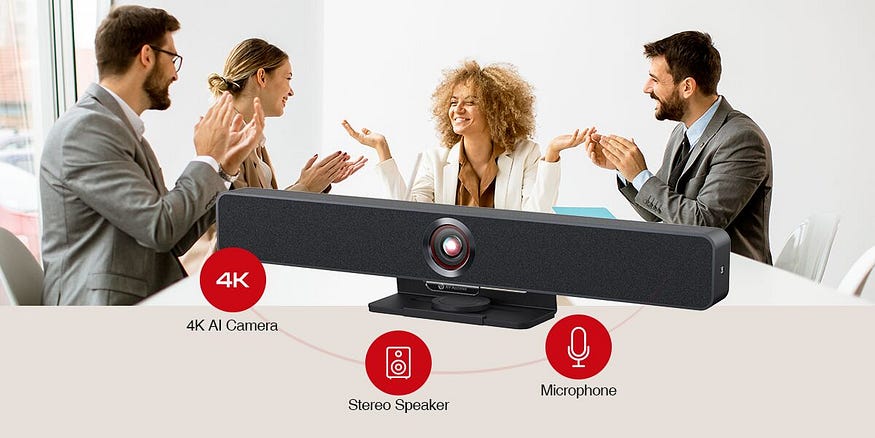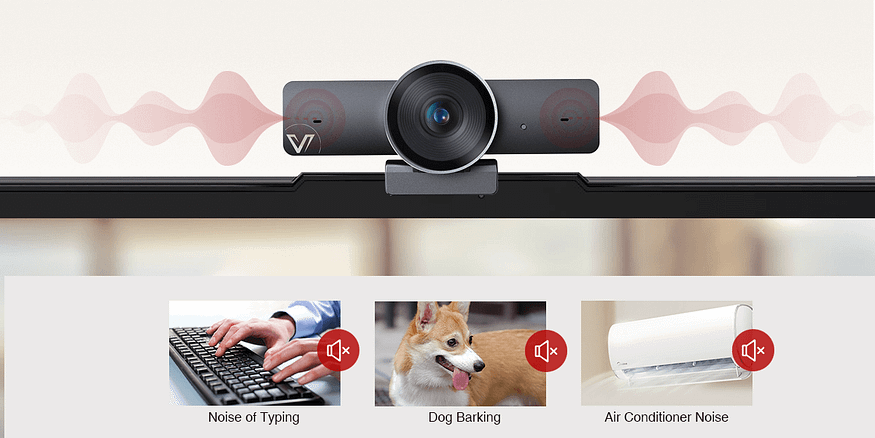Nowadays, AI technology has made remarkable advancements in its utilization and growth within the realm of ITAV (UC), particularly in video conferencing and remote teaching. Furthermore, its potential for further expansion and innovation remains vast and promising as we look towards the future.
In this article, we will briefly introduce some of AI achievements in terms of video applications and voice applications in video conferencing and remote teaching, as well as explain its future development.
Development of AI in Video Applications
- Video Enhancement: Improve video quality through AI technology, including noise reduction, automatic white balance, automatic backlight compensation, etc.
- Automatic Tracking and Framing: This AI technology can be used to automatically track the movements and positions of participants to ensure they are always in the frame. The camera can be controlled to adjust its filed of view.
- Eye Contact: This AI technology can adjust the direction of human eyes to the camera so that they are facing the screen, which will give participants a more face-to-face meeting experience.
- Gesture Recognition: AI recognizes specific gestures captured in the camera images, and then triggers corresponding operations. In some special occasions, such as training, the teacher uses gestures to switch between different AI modes of the camera.
- Face Recognition: AI face recognition technology has been widely used in scenarios such as meeting sign-in, meeting nameplates, training sign-in, and training roll call.
- Video Content Analysis: In video conferencing, AI technology further analyzes video content, such as whiteboards, screen sharing or presentations, and provides better visualization and annotation capabilities.
- Virtual Backgrounds and Filters: Virtual background and filter technology allows users to customize the look of their videos. AI can be used to identify and apply virtual backgrounds in real time, and filters can be added to improve video quality.
- Multi-Camera Collaboration: A single camera lens or multi-camera lens captures the images of multiple participants and presents them on the screen at the same time to create a more friendly and immersive video conferencing experience. In teaching, multi-camera lenses can also provide richer teaching content.
If you are looking for an all-in-one solution for video conferencing, AV Access AnyCo V8 video bar will be your optimal choice. It supports 3 smart AI tracking modes: auto framing, presenter tracking and speaker tracking. You can switch these modes easily via the side panel control button or the “AV Access BizEye” App.
With these AI tracking modes, AnyCo V8 can automatically adjust its field of view to frame all attendees in the meeting room, follow and track the presenter in real time, or intelligently focus on the speaker.

Development of AI In Voice Applications
- Voice Enhancement: Adopts AI technology to achieve intelligent noise reduction and voice enhancement to capture clear and smooth voice.
- Audio-Assisted Video: The sound source localization technology assists the camera in capturing images, ensuring that the speaker remains in the center of the image.
- Real-Time Translation and Subtitles: In video conferencing, real-time translation and subtitles are provided through AI voice recognition technology and natural language processing technology (NLP) to support multi-language communication.
- Intelligent Meeting Management: In video conferencing, AI technology can also automatically record meeting content, organize meeting minutes and other important information.
If you are looking for a high-quality AI webcam for capturing audio and video in your remote meeting, AV Access BizEye 80 can be your best choice. In addition to auto framing and presenter tracking, BizEye 80 is equipped with dual AI noise-canceling microphones. They can filter out wind noise, keyboard typing, dog barking and other environmental noises, delivering crystal clear audio to the remote side.

Future Development Trends of AI in Video Conferencing
In the future, AI will further perform deep learning and analysis on video content.
- Expression Analysis: Facial recognition can further analyze participants’ facial features and expressions to provide a more interactive and personalized experience, making virtual meetings and training environments more immersive.
- Authentication & Security: Identify and verify the identity of participants, enhancing the security of video conferencing.
- Privacy Protection: Privacy protection is also an important topic, and AI technology can also provide better privacy filtering and data security measures.
- Automation Realized by Multi-Modal Perception: The camera will be combined with other perception technologies, such as voice recognition, depth sensor and infrared technologies, to provide more comprehensive environmental perception, intelligently adjust the environment configuration, and achieve the best meeting or training experience in real time.
That’s all for the article. If you want to learn more about AI products for video conferencing, you can refer to AV Access’s hybrid conference solutions.
Source: https://www.avaccess.com/blogs/guides/ai-technology-in-video-conferencing/

No comments yet